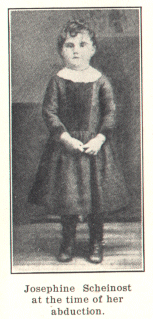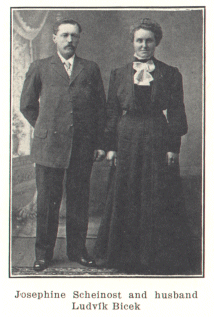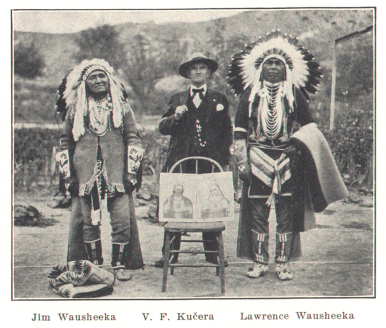 |
Brown County--1885 |
This is a NEGenWeb Project web page
and is presented as part of the
MARDOS Memorial Library Collection.
Brown County--1885
|
Czechs began to settle in this county about 1885, but practically all left in a very short time. In those days it was a part of Rock County, for in 1893 Brown County was created out of a part of the former. It was a grazing country and Czechs were grain farmers. Among the earliest were the following, most of whom moved to Boyd County, where their names will be found with birthplaces (when available) and some went to Gregory County, South Dakota: Anton Hambek, Vaclav Hambek, Frank Scheinost, Matej Scheinost, Eman Scheinost, Albert Scheinost, Jacob Cerny, Vaclav Kral, John Flidr, Joseph Svoboda, John Janousek, John Havranek, John Pokorny. Frank Protivinsky, Frank Holubar, Frank Smolik; Vaclav Nermut, Joseph Fisher, Joseph Sisr, Joseph Novotny, Frank Bednar, Frank Sladek, Jelinek and Alois (Louis) Janousek. Anton Pokorny was rural mail carrier for two years, traveling a long distance, spending the night in Butka. John Pokorny, born in Znojmo, Moravia, came to St. Paul, Nebraska, in 1887. In 1888 he took a claim in Brown County, as did his sons, Anton, Frank and Charles. They were all driven out by the drouth and moved to Valley, Custer and Garfield counties. Even this short and unsatisfactory stay in a new neighborhood brought great mental anguish to one family, that of Matej Scheinost (Sajnost). In the spring of 1888 the families of Matej Scheinost and Vaclav Hambek, brothers-in-law (their wives being sisters) moved to Brown from Valley County. At that time there were about ten other Czech families living there. During the first summer both families lived in a house rudely constructed by Scheinost on his land. In the fall Hambek built a house on his homestead and Scheinost proceeded to put up a substantial sod house for the winter. One day his wife and her sister came over with the children, to see how he was getting on. About a mile and a half distant was a large lake, whither the women repaired to gather firewood. They took some of the children with them, but left the three younger girls with the father. Josephine, the youngest, two years old, fell asleep. The father carried her to the old house and put her to bed. When the other children went in later, they were surprised to find her gone. They informed their uncle Mr. Hambek, who thought she had followed her mother. The Scheinost house stood near the road. Three miles away was a large cattle ranch, the cattle sometimes straying over the homesteads. A certain cowboy used to round them up and often stopped for a drink at the Scheinost well. When the women had gathered enough wood, they returned. Having traversed about a mile, they beheld the cowboy riding down the road and concluded that he had, as usual, stopped for a drink. The two dogs that had accompanied them proceeded to follow him, barking wildly, but he vanished among the hills. The children ran to meet the women, asking for Josephine. When the frightened mother questioned the father, he assured her he had put the child on the bed, but that was found to be vacant. An alarm was spread and neighbors began to search the country. In vain. Someone expressed the fear that the child had been stamped to death by cattle, so one of the neighbors (the parents being unable to speak English) volunteered to visit the ranch for information. The ranchman thought the possibility unlikely, as during a stampede the cattle makes much noise and that had not been heard. Suddenly the cowboy, who thus far had not said anything, made the statement that the girl was not dead and could be found, but despite pressure he would say no more. When the neighbor reported to the parents, they begged him to go again and implore the cowboy to tell, but he had left the place that evening and all trace of the child was lost. 
One day in the following spring Barbara, another daughter, came running into the vegetable garden, where the mother was working, to say that a covered wagon had stopped at their place, the people in it wanting to get a drink. Barbara had looked into the wagon and thought she saw Josephine lying therein. The mother hastened home, but the wagon was gone and she did not know in what direction. Besides, there was no certainty that the child was hers. It may have resembled Josephine and nothing more, but the old wound bled afresh. The Scheinosts lived in Brown County five years, moving then to Boyd County. Hambeks moved with them, living on adjoining farms, and they prospered better. Fourteen years had passed since Josephine had disappeared, when one Sunday afternoon a neighbor's daughter, Mary Holecek, called and told them she had read in a Czech paper an item to the effect that a certain woman was looking for the parents of a child lost fourteen years before. The paper had been destroyed accidently and when the parents wrote the publisher, they recived no reply. Four years more went by. Anton Scheinost, brother of Matej, lived in Butte. One day his young daughter, walking across the yard, saw an English-language paper flying about and upon picking it up, read that the Omaha chief of police was looking for information about a child lost in Nebraska eighteen years before, aged two years. She showed it to her mother and her father wrote to the chief, asking for the girl's address, which was furnished. The girl's name was given as Lila Franklin, and Mr. Scheinost wrote to her. Lila answered that she could not remember her abduction; that all she knew was that as a little child she had lived here and there, never long anywhere; that at times she stayed with a woman whom she considered her mother and at other times with strangers. When she was five years old, her mother took her with her when she travelled, for she was a member of a troupe of travelling performers. Later the woman married a miller named Franklin, but the marriage did not last, owing to the mother's bad temper, and she proceeded to travel around again, this time with a man named Bird. The child was forced to learn various tricks and when she could not perform them well, her foster parents punished her by hunger and beatings. Once, during a severe punishment, she was taken away and remembered staying in a place where there were many other children. She played with them in a garden one day, when a boy came to her to say that her mother wanted him to bring her back. Being in deadly fear of the woman, she went with him and her sad life began all over again. Once Bird bought a baloon and announced he would take his "daughter" with him. When the time for the performance arrived, the child, horribly frightened, could not be induced to get in. The audience intervened and would not allow him to proceed. For that she was beaten with a rope so painfully that she lay in bed for days. 
After a time Bird died and the mother with Lila moved to Chicago, where the elder woman was stricken with cancer. Lila was then sixteen and in spite of the cruel treatment received, served her mother faithfully. When the mother knew she must die, she told the girl she was sorry for not having been kinder to her and told her to go to her sister in St. Louis, after her death, and ask for her ring. Lila did as directed, but the woman's sister would not give up the ring, saying it was her property, because the girl was not her sister's own child. She told Lila her sister had abducted her in 1888, but would say no more. Lila returned to Chicago and confided in her neighbor, her good friend. This neighbor told her husband and these kind people advertised in English-language papers, trying to reach the parents, but to no avail. At last the man thought of writing to the Omaha chief of police, and thus the right way was found. The chief in turn advertised, for he found that in 1888 no other child but Josephine Scheinost had been abducted in Nebraska. He discovered too that in 1894, in Stuart, Holt County, a woman belonging to a travelling troupe had been indicted for mistreating a child, which had been placed in an orphanage, whence it disappeared shortly thereafter. Mr. Scheinost's brother Anton lived in Butte, Boyd County, at the time. His daughter saw the chief's appeal, told her parents and her father wrote, but the chief did not know Lila's address and had to advertise for that, with good results. Lila answered and was put in touch with her uncle Anton and so at last Scheinosts found their long-lost daughter. She could not speak Czech, but her brothers and sisters interpreted until she learned it. In 1910 she married a Czech, Frank Bicek, and lives near Colome, South Dakota. Scheinosts never discovered how or why their daughter was abducted. All that was ever found out was that the wife of their neighbors named Ormsby was a sister of the woman who took Lila, and the cowboy in question used to take care of the Ormsby cattle. The woman was visiting her sister at the time. The parents conjectured that for some reason she needed a child she could represent as her own and when she had it, made use of it in her performance.
The colony in this county settled in the vicinity of Lodge Pole, Colton and Sidney, and was founded by V. F. Kucera, a locator, who advertised in the Pokrok Zapadu. When the nucleus was formed, others followed their friends and relatives. 1885--The Following Came: Vaclav Verner was the first to come. Born in Ruda, Nove Straseci. Vaclav Librcajt, second; V. F. Kucera, third, born 1859 in Jarov, county Plzen. 1886--The Following Came: A. J. Krikac, being the fourth. Born in Luzany, Prestice, now living in Butte, Boyd County. This colony, like others in the western part of the state, suffered from drouth and most of the settlers moved away in the early nineties. About that time, before the exodus, the following were living there: P. O. Lodge Pole: Vaclav Kutis, Chvalsovice, Hluboka; Vaclav Mika, Hluboka; John Pavlat, Doudleby, Kostelec nad Orlici; Joseph Bel, Luzany, Prestice; John Jenik, Tisova, Vysoke Myto; Frank Vinkler, Radnice, Rokycany; Anton Henzl, Syre, Zbirov; Anton Kriz, Sudislav, Kostelec; Frank Zalensky, Horky, Litomysle; Joseph Oliverius, Jarov, Kralovice; Matej Strejc, Tachlovice; Anton Gottstein, Jilemnice; Karel (Charles) Zabokrtsky, Slemeno, Rychnov; Leopold Mach, Borovnik, Velka Bytes; Joseph Kulyk, Katov; Joseph and Frank Lapis, Dolni Vilimovice, Trebic; Vaclav Vacik, Stryckovice, Klatovy; Joseph Ledvina, Karlik, Zbraslav; John Studlar Sr., Kralovice, Prachatice; Catherine Klein, Frantoly, Prachatice; Henry Strejc, Tachlovice, Smichov; Felix Polacek, Radomysl, Strakonice; Vaclav Polacek, same; Joseph Vecera, Zvolec, Namest; John Pochop, Dlouhe, Nove Mesto; Frank and Vaclav Vosika, Klenov, Veseli. P. O. Colton: Joseph Prochazka, Bystrice, Nove Mesto; Joseph Homolka, Bystrice, Nove Mesto; Anton Krupicka, Tachlovice, Smichov; Joseph Lukas, Ostrov Zdar; Vaclav, John, Frank and George Seda, Ujezd, Vysoke Myto; Anton Chlouba, Trtice, Nove Straseci. P. O. Sidney: Joseph Henzl, Syre, Zbirov; Leo Rezanina, unknown; Frank Sasek, Jehnedlo, Pisek; Adam Simka, Krecovice, Tyn nad Rovenskem; Matej Mertl, Koryta, Kralovice; Luke Studlar, Kralovice; Peter and John Sukovaty, Stechov, H. Tyn.  P. O. Potter: Frank Slama Sr., and Joseph Slama, Slovan, Pribram; Anton Benes, Kopidlno, Kralovice; John and Frank Lundak, Obory, Pribram. P. O. Redington: Peter Hynek, Kellnersville, Wisconsin; Frank Vopat, Nebreziny, Kralovice. Mr. Andrew J. Krikac, now living in Butte, Boyd County, one of the early settlers, writes: "I arrived in Valley County in 1881 from Bohemia, where I was born in Luzany, Prestice, coming to my cousin Charles Cesak, who that spring had settled near Sedlov, in the northwestern part of Valley County. This postoffice was established by John Beran, who was postmaster and who had named it for a town in Bohemia. The following spring I settled on a homestead seven miles west of Cesak in Custer County. During the summer I worked in Howard County, on farms or at my carpentering trade, and spent the winters on my homestead. In 1885 I sold my claim to Joseph Klanecky and lived near Sedlov with my parents, who had come in 1883. During that time I began to dig wells, some as deep as 250 feet. I read V. F. Kucera's advertisements in the Pokrok Zapadu about Cheyenne County and with a party set out to investigate. I was the only one to settle. Some of the others took claims but did not move there until the following spring. Most of those shown on the list were early settlers. There being no other employment to be had, I dug wells, but it was hard work, for I had to dig through several layers of gravel and rock. It was not only difficult but dangerous work and no one but I could handle it. Once I was obliged to dig eighty feet deep to get the body of a digger who had perished at his work, the well having caved in. About two hundred people had gathered, among them several well-diggers, but none cared to risk his life. I worked all day and all night, before I reached the unfortunate man's head and found he was dead. It required three nights' and two day's work to get the corpse out (Doc. Mann) and to this day I have not received pay for it. In the spring of 1887 I married Miss Seda and began farming, but one dry year followed another and so in July, 1890, I put my wife and two little girls in an old covered wagon and started east. Five miles east of Chappell our horses became frightened, for the wind had blown out the cover on our wagon. The shaft fell out of the neckyoke, broke in half, our wagon raised up and flew over. I unharnessed and went to the nearest house, asking the loan of a wagon to get to Julesburg, Colorado, where I wanted to get mine repaired. Imagine my surprise when the man spoke Czech to his wife. I then addressed them also in Czech and they in turn were surprised, for none of our countrymen lived in that vicinity. My wagon was repaired, and we proceeded, but how painfully, for we did not dare to put the cover on again, and for eleven days following we had to bear the hot, blazing sun. Both children became ill, as a result. At last, on August 1st, we reached my parents in Geranium, Valley County, where I rented a farm for three years. In 1893 I moved to Boyd County, where for a year I was in the saloon business with my cousin Charles Cesak. The next spring I moved to Butte, where I now live." |
| Back | Table of Contents | Next |